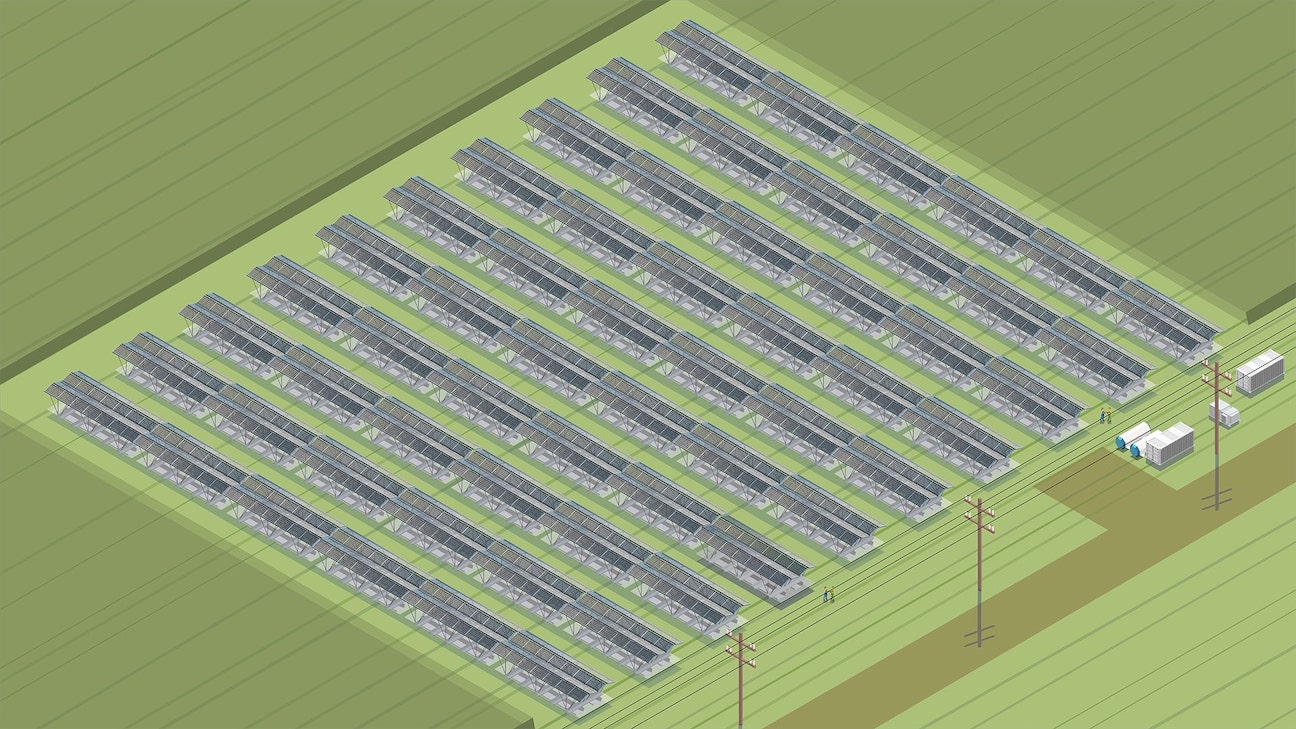Pop-Up Solar: Can Farmers Make Fertilizer, Fuel and Electricity from the Sun?

Can farmers make their own fertilizer, fuel and electricity from the sun? Welcome to TrackerSled, a pop-up 3.5-acre solar farm intended to provide energy independence and profit potential.
“By 2030, farmers will be using electricity—made on their land—to produce fertilizer and a diesel alternative, and sell power, and get a premium on carbon-free crops,” says Larry Kearns, founder of TrackerSled.
Use It or Lose It
At present, solar farms on agricultural operations usually are owned by developers that remove big acres from production. “If you’re a farmer lucky enough to be close to a substation or transmission lines, you can lease your land to a solar company and make more than you could in farming and that’s great, but there is a better way,” says Kearns.

“Instead, a farmer can own the solar asset and keep the money local,” Kearns continues. “Farmers use modest electricity right now, but that is about to change.”
Can a 3.5-acre solar farm power a 1,000-acre grain operation? No problem, Kearns insists. TrackerSled’s solar farm comprises roughly 60 SunFarmor modules resembling trestle bridges placed on 3.5 acres. The SunFarmor modules are ground-agnostic—assembled roadside in roughly two hours and towed to a farmyard, roadside, or head row location. No surveys, pile driving, permanent holes, or special engineering required. “All cabling is 12’ aboveground, away from cattle, and the solar farm doesn’t require fencing,” Kearns explains. “There are no soil borings and no penetration of the ground and the modules can be moved if needed. A total of two weeks and the solar farm is in operation.”
Electricity, when produced by solar power, must be consumed instantaneously. TrackerSled, however, aims to turn the use-it-or-lose-it proposition on its head.
Electricity, Air and Water
In contrast to a battery, energy stored in a molecule doesn’t degrade over time. Ammonia is the key to solar storage, according to Kearns. “If a farmer produces hydrogen and ultimately ammonia, they are storing that energy in a molecule, instead of a chemical battery. For example, the ammonia I produce in winter is stockpiled year-round. I can then use it as fuel or fertilizer.”
Electricity, air, and water are the simple players in ammonia production. TrackerSled enables farmers to use sunshine to create electricity and produce ammonia, according to Kearns. The anhydrous, he says, would then be used as fuel for tractors and trucks, or as fertilizer. “Most ammonia used in the Corn Belt comes from overseas and eventually is piped to the Midwest. Why not make your own with solar?”
Using TrackSled’s setup, how would a farmer manufacture anhydrous? Containerized ammonia plants are already on the market, Kearns notes. He points to FuelPositive, AmmPower, and Starfire Energy as examples. “About two-thirds of SunFarmor module energy production would go electrolysis—splitting a bathtub of water per day into oxygen and hydrogen. The technology for this electrolysis can ramp up and down according to available power, but it would produce 12 months a year. When the sun shines, you’re making fuel and fertilizer.”
“You’re going to see more and more tractors and trucks powered by ammonia—fuel that can all be made right on a farm,” Kearns adds. “All farmers need fuel and fertilizer, and this system can be adjusted to fit any farm size.”
The Future?
How much would TrackerSled’s solar farm cost? “The modules are guaranteed for 30 years. Our price target is $2 per watt for the nameplate,” Kearns says. “If you have a 3.5-acre, 1 megawatt farm, that equates to a $2 million investment. However, the Inflation Reduction Act will cover 40-50%, and you can get an additional Renewable Energy for America Program (REAP) grants, and stack other grants on top, and then sell crops at a carbon-free premium.”

Currently, TrackerSled is planning a series of field trials to gain certification. “A lot of farmers will want to do this just to sell power,” Kearns says. “In Illinois, for example, you’d make a 50% internal rate of return by selling power back to the grid because there are so many incentives in that state.”
Solar farms—owned entirely by producers—will be seamless fits of overall agricultural operations, Kearns contends. “Fuel, fertilizer, power, and premiums directly from a farmer are the future and the market is going to respond in a way we’ve never seen.”







